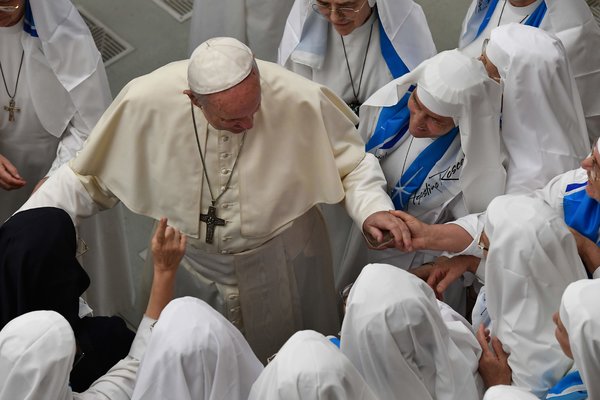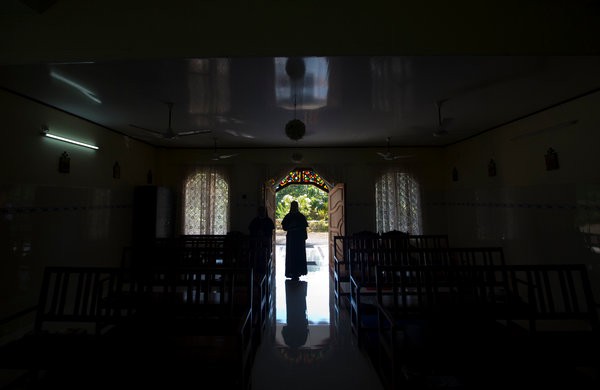Sexual Abuse of Nuns: Longstanding Church Scandal Emerges from Shadows
By Jason Horowitz
The sexual abuse of nuns and religious women by Catholic priests and bishops — and the abortions that have sometimes resulted — has for years been overshadowed by other scandals in the Roman Catholic Church. That seemed to change this week when Pope Francis publicly acknowledged the problem for the first time. “I was so happy,” said Lucetta Scaraffia, the author of an article denouncing the abuse of nuns and religious lay women by priests that was published this month in a magazine, Women Church World, which is distributed alongside the Vatican’s newspaper. Speaking from her Rome apartment, which she said had essentially been converted into a television studio full of international reporters, Ms. Scaraffia said, “Finally, now many women will have the courage to come forward and denounce their abusers.” The pope’s remarks on Tuesday, in response to a question posed on the papal plane about Ms. Scaraffia’s article, came after decades of persistent allegations of such abuses, and seeming Vatican inaction, which has now collided with the heightened awareness of the #MeToo era. They also came just ahead of an extraordinary conference of bishops on sexual abuse scheduled this month at the Vatican. But it was the pope’s dramatic, and according to the Vatican on Wednesday, inaccurate, description of one example of such abuse as “sexual slavery” that most caught the world’s attention. “When the Holy Father, referring to the dissolving of a congregation, spoke of ‘sexual slavery’ he meant ‘manipulation,’ ” the pope’s spokesman, Alessandro Gisotti, clarified in a statement to reporters on Wednesday. Advocates of abused nuns were relieved the pope had at last put the issue on the church’s radar. But they also noted that it was a long time coming and that the pope’s other remarks Tuesday did not inspire confidence in a speedy solution. In his typically free-associating riff, Francis acknowledged “there have been priests and bishops” who have committed sexual abuse against nuns, and that “it’s continuing because it’s not like once you realize it that it stops.” He said the church needed to do more. But while attempting to show that his predecessor, Benedict XVI, took tough action on the issue of sexual abuse against nuns, he recalled a separate case of a religious order marred with sexual and economic corruption, but apparently was not one involving nuns. Francis recounted that Benedict, then known as Cardinal Joseph Ratzinger, the church’s doctrinal watchdog, marshaled all his evidence against the complicit order in a meeting with Pope John Paul II. Francis said Benedict returned defeated and told his secretary, “The other side won.” Francis added in an aside, “We should not be scandalized by this — it’s part of a process.”
His point seemed to be that pursuing justice in the church takes time and he said that when Benedict became pope he immediately told his secretary to get him the files “and he began.” But his example confounded advocates of nuns abused by priests, who noted that the pope is the single person within the church with absolute authority to take action at any time. “I was wondering when he said they were dealing with the problem for a long time, because we just don’t know what those actions are,” said Zuzanna Flisowska, the general manager of Voices of Faith, a group advocating for more participation by women in lay leadership positions inside the church. “We feel a little disappointed that it has to be the media who has to press the church and the pope to comment,” she added. Experts say there is no shortage of factors contributing to the abuse, its cover up and the lack of action inside the Vatican. Karlijn Demasure, the former executive director of the church’s Center for Child Protection at the Pontifical Gregorian University, where she is a professor and expert in the sexual abuse of minors and vulnerable adults, said there is no data on how widespread the problem is. But, she added, anecdotal evidence suggests “it’s not exceptional.” Many members of the church, experts said, suffer from a medieval mind-set and consider the priests who commit abuse against nuns to be the victims of seductive temptresses. Since the victims in these cases are adults, the experts say, there is also a reflexive tendency to blame them. The reductive public image of the nun as existing to serve the priest and to pray quietly also undercuts those who speak up. Often, the abuse occurs in a relationship of spiritual guidance, Professor Demasure said, with the priest grooming the victim over time, as is often the case in cases of child sexual abuse. The apparent preponderance of such abuse in Africa and India has led some in the church to chalk the abuse up to cultural differences. In many cases, sexual favors have been required of nuns who are financially dependent on priests, and traditions of subservience by women make them vulnerable to abuse. Ms. Scaraffia said she subscribed to the pope’s critique of abuse, that it is rooted in a rot in clerical culture that leads priests to believe they are a higher authority, and thus entitled to do what they want with their parishioners. In developing countries, where the abuse of nuns seems more prevalent, priests tend to be put on even higher pedestals. Professor Demasure said there is also the delicate issue that female superiors have covered up the abuse of their nuns to protect the reputation of the church, just as bishops have done with pedophile priests. “I’m afraid that’s a similar thing,” she said. So is the failure to heed alarm bells. As far back as the 1990s, members of religious orders prepared private reports on the issue for top Vatican officials. In 1994, Sister Maura O’Donohue sent the Vatican the results of a multiyear, 23-nation survey about such abuse, which was especially rampant in Africa where nuns were considered safe sexual partners for priests who feared infection by H.I.V. One 1998 report focused on Africa observed that “sexual harassment and even rape of sisters by priests and bishops is allegedly common.” “When a sister becomes pregnant, the priest insists that she have an abortion,” the report added. ‘‘The sister is usually dismissed from her congregation while the priest is often only moved to another parish — or sent for studies.” African bishops briefed at the time decried the reporting of abuse as “disloyal.” Among the private reports by nuns in the 1990s, which were published in a cover story by The National Catholic Reporter in 2001, one asserted that 29 nuns had become pregnant in one order alone. Professor Demasure said there are firsthand testimonies about such abortions, which would break one of the central tenets of church teaching and potentially violate local laws, but she said there was no data about how widespread they are. But the problem has clearly not gone away. In 2013, the Rev. Anthony Musaala, a priest in Kampala, Uganda, was suspended and forced to apologize for raising concerns about his fellow priests engaging in sexual relationships with women, including nuns. In India, Bishop Franco Mulakkal of Jalandhar currently faces charges for repeatedly raping a former mother superior of a congregation. While he has denied the charges, more than 80 nuns signed a July letter urging that he be removed from pastoral work. Ms. Scaraffia said the abuse of nuns occurs “not only in the third world.’’ ‘‘It’s all over,’’ she said. ‘‘It’s in Europe.” An investigation this summer by Nicole Winfield, the Associated Press reporter who asked the pope the question about abuse on the papal plane, documented abuse on at least four different continents. In November, the International Union of Superiors General, or U.I.S.G., the organization representing the world’s female Catholic religious orders, published an extraordinary statement that called on women religious who have suffered abuse to come forward and report it to church and state authorities. “If the U.I.S.G. receives a report of abuse, we will be a listening presence,” the statement said. “We condemn those who support the culture of silence and secrecy, often under the guise of ‘protection’ of an institution’s reputation or naming it ‘part of one’s culture,’ ” it added. In December, the Vatican began investigating the Institute of the Good Samaritan, a small Chilean religious order of nuns, after Chilean national television revealed that some sisters had been thrown out after reporting sexual abuse by priests and maltreatment by their superior. Ms. Scaraffia, getting ready for her next interview in Rome, said she sensed momentum and was confident now that “the pope understands the problem.” She added, “This is surely the first step.”
|
.
Any original material on these pages is copyright © BishopAccountability.org 2004. Reproduce freely with attribution.

